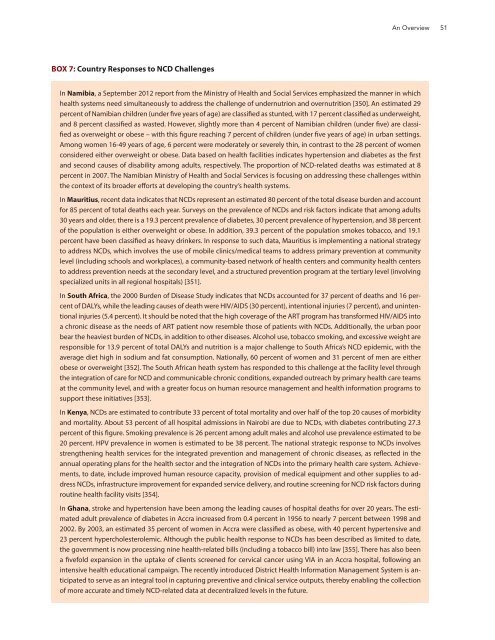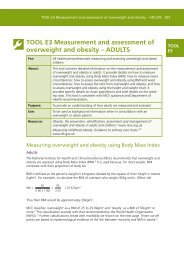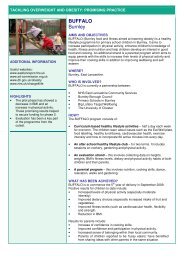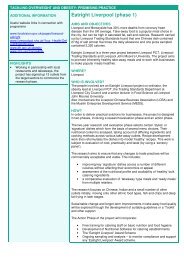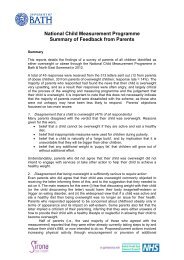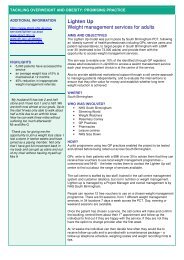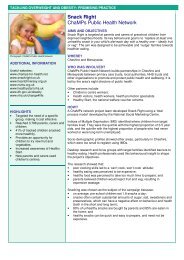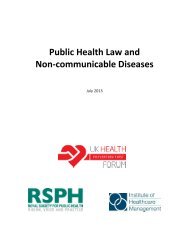The Challenge of Non-Communicable Diseases and Road Traffic ...
The Challenge of Non-Communicable Diseases and Road Traffic ...
The Challenge of Non-Communicable Diseases and Road Traffic ...
You also want an ePaper? Increase the reach of your titles
YUMPU automatically turns print PDFs into web optimized ePapers that Google loves.
An Overview 51<br />
BOX 7: Country Responses to NCD <strong>Challenge</strong>s<br />
In Namibia, a September 2012 report from the Ministry <strong>of</strong> Health <strong>and</strong> Social Services emphasized the manner in which<br />
health systems need simultaneously to address the challenge <strong>of</strong> undernutrion <strong>and</strong> overnutrition [350]. An estimated 29<br />
percent <strong>of</strong> Namibian children (under five years <strong>of</strong> age) are classified as stunted, with 17 percent classified as underweight,<br />
<strong>and</strong> 8 percent classified as wasted. However, slightly more than 4 percent <strong>of</strong> Namibian children (under five) are classified<br />
as overweight or obese – with this figure reaching 7 percent <strong>of</strong> children (under five years <strong>of</strong> age) in urban settings.<br />
Among women 16-49 years <strong>of</strong> age, 6 percent were moderately or severely thin, in contrast to the 28 percent <strong>of</strong> women<br />
considered either overweight or obese. Data based on health facilities indicates hypertension <strong>and</strong> diabetes as the first<br />
<strong>and</strong> second causes <strong>of</strong> disability among adults, respectively. <strong>The</strong> proportion <strong>of</strong> NCD-related deaths was estimated at 8<br />
percent in 2007. <strong>The</strong> Namibian Ministry <strong>of</strong> Health <strong>and</strong> Social Services is focusing on addressing these challenges within<br />
the context <strong>of</strong> its broader efforts at developing the country’s health systems.<br />
In Mauritius, recent data indicates that NCDs represent an estimated 80 percent <strong>of</strong> the total disease burden <strong>and</strong> account<br />
for 85 percent <strong>of</strong> total deaths each year. Surveys on the prevalence <strong>of</strong> NCDs <strong>and</strong> risk factors indicate that among adults<br />
30 years <strong>and</strong> older, there is a 19.3 percent prevalence <strong>of</strong> diabetes, 30 percent prevalence <strong>of</strong> hypertension, <strong>and</strong> 38 percent<br />
<strong>of</strong> the population is either overweight or obese. In addition, 39.3 percent <strong>of</strong> the population smokes tobacco, <strong>and</strong> 19.1<br />
percent have been classified as heavy drinkers. In response to such data, Mauritius is implementing a national strategy<br />
to address NCDs, which involves the use <strong>of</strong> mobile clinics/medical teams to address primary prevention at community<br />
level (including schools <strong>and</strong> workplaces), a community-based network <strong>of</strong> health centers <strong>and</strong> community health centers<br />
to address prevention needs at the secondary level, <strong>and</strong> a structured prevention program at the tertiary level (involving<br />
specialized units in all regional hospitals) [351].<br />
In South Africa, the 2000 Burden <strong>of</strong> Disease Study indicates that NCDs accounted for 37 percent <strong>of</strong> deaths <strong>and</strong> 16 percent<br />
<strong>of</strong> DALYs, while the leading causes <strong>of</strong> death were HIV/AIDS (30 percent), intentional injuries (7 percent), <strong>and</strong> unintentional<br />
injuries (5.4 percent). It should be noted that the high coverage <strong>of</strong> the ART program has transformed HIV/AIDS into<br />
a chronic disease as the needs <strong>of</strong> ART patient now resemble those <strong>of</strong> patients with NCDs. Additionally, the urban poor<br />
bear the heaviest burden <strong>of</strong> NCDs, in addition to other diseases. Alcohol use, tobacco smoking, <strong>and</strong> excessive weight are<br />
responsible for 13.9 percent <strong>of</strong> total DALYs <strong>and</strong> nutrition is a major challenge to South Africa’s NCD epidemic, with the<br />
average diet high in sodium <strong>and</strong> fat consumption. Nationally, 60 percent <strong>of</strong> women <strong>and</strong> 31 percent <strong>of</strong> men are either<br />
obese or overweight [352]. <strong>The</strong> South African heath system has responded to this challenge at the facility level through<br />
the integration <strong>of</strong> care for NCD <strong>and</strong> communicable chronic conditions, exp<strong>and</strong>ed outreach by primary health care teams<br />
at the community level, <strong>and</strong> with a greater focus on human resource management <strong>and</strong> health information programs to<br />
support these initiatives [353].<br />
In Kenya, NCDs are estimated to contribute 33 percent <strong>of</strong> total mortality <strong>and</strong> over half <strong>of</strong> the top 20 causes <strong>of</strong> morbidity<br />
<strong>and</strong> mortality. About 53 percent <strong>of</strong> all hospital admissions in Nairobi are due to NCDs, with diabetes contributing 27.3<br />
percent <strong>of</strong> this figure. Smoking prevalence is 26 percent among adult males <strong>and</strong> alcohol use prevalence estimated to be<br />
20 percent. HPV prevalence in women is estimated to be 38 percent. <strong>The</strong> national strategic response to NCDs involves<br />
strengthening health services for the integrated prevention <strong>and</strong> management <strong>of</strong> chronic diseases, as reflected in the<br />
annual operating plans for the health sector <strong>and</strong> the integration <strong>of</strong> NCDs into the primary health care system. Achievements,<br />
to date, include improved human resource capacity, provision <strong>of</strong> medical equipment <strong>and</strong> other supplies to address<br />
NCDs, infrastructure improvement for exp<strong>and</strong>ed service delivery, <strong>and</strong> routine screening for NCD risk factors during<br />
routine health facility visits [354].<br />
In Ghana, stroke <strong>and</strong> hypertension have been among the leading causes <strong>of</strong> hospital deaths for over 20 years. <strong>The</strong> estimated<br />
adult prevalence <strong>of</strong> diabetes in Accra increased from 0.4 percent in 1956 to nearly 7 percent between 1998 <strong>and</strong><br />
2002. By 2003, an estimated 35 percent <strong>of</strong> women in Accra were classified as obese, with 40 percent hypertensive <strong>and</strong><br />
23 percent hypercholesterolemic. Although the public health response to NCDs has been described as limited to date,<br />
the government is now processing nine health-related bills (including a tobacco bill) into law [355]. <strong>The</strong>re has also been<br />
a fivefold expansion in the uptake <strong>of</strong> clients screened for cervical cancer using VIA in an Accra hospital, following an<br />
intensive health educational campaign. <strong>The</strong> recently introduced District Health Information Management System is anticipated<br />
to serve as an integral tool in capturing preventive <strong>and</strong> clinical service outputs, thereby enabling the collection<br />
<strong>of</strong> more accurate <strong>and</strong> timely NCD-related data at decentralized levels in the future.


